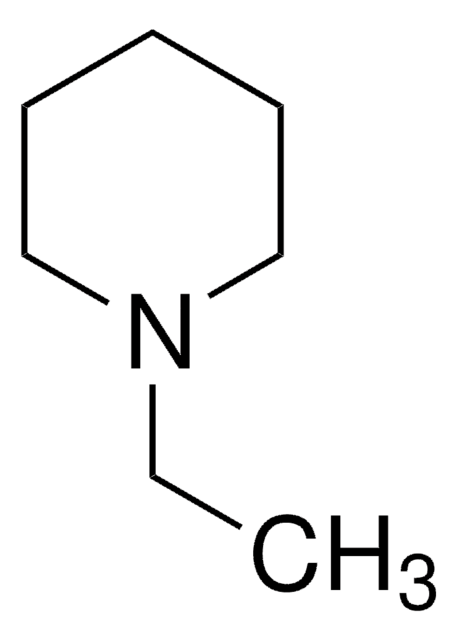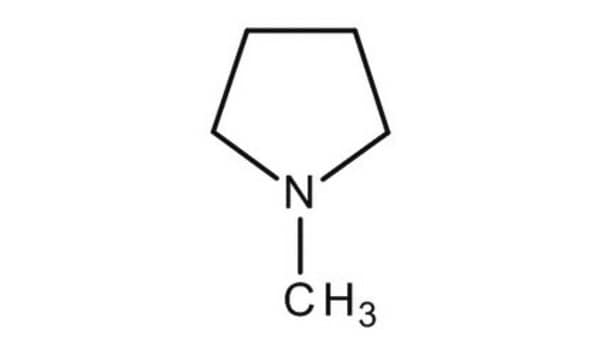69110
1-Methylpyrrolidine
≥98.0% (GC)
Synonym(s):
N-Methylpyrrolidine, N-Methyltetrahydropyrrole
Sign Into View Organizational & Contract Pricing
All Photos(1)
About This Item
Empirical Formula (Hill Notation):
C5H11N
CAS Number:
Molecular Weight:
85.15
Beilstein:
102445
EC Number:
MDL number:
UNSPSC Code:
12352100
PubChem Substance ID:
NACRES:
NA.22
Recommended Products
Quality Level
Assay
≥98.0% (GC)
form
liquid
refractive index
n20/D 1.425
bp
76-80 °C (lit.)
density
0.800 g/mL at 20 °C (lit.)
SMILES string
CN1CCCC1
InChI
1S/C5H11N/c1-6-4-2-3-5-6/h2-5H2,1H3
InChI key
AVFZOVWCLRSYKC-UHFFFAOYSA-N
Looking for similar products? Visit Product Comparison Guide
Application
1-Methylpyrrolidine is extensively used in the synthesis of pyrrolidine based ionic liquids. Some of the other reported applications include:
- Synthesis of ionic liquid electrolytes for primary Li/CFx batteries.
- Preparation of ionic liquid as a reaction medium to carry out sulfuric acid-catalyzed conversion of alkynes to ketones.
- MCM-47, a highly crystalline ferrierite layered silicate, can be synthesized using a diquaternary ammonium salt prepared from the reaction of 1-methylpyrrolidine with 1,4-dibromobutane.
Signal Word
Danger
Hazard Statements
Precautionary Statements
Hazard Classifications
Acute Tox. 3 Oral - Acute Tox. 4 Inhalation - Aquatic Chronic 2 - Flam. Liq. 2 - Skin Corr. 1A
Storage Class Code
3 - Flammable liquids
WGK
WGK 3
Flash Point(F)
-0.4 °F - closed cup
Flash Point(C)
-18 °C - closed cup
Personal Protective Equipment
dust mask type N95 (US), Eyeshields, Gloves
Choose from one of the most recent versions:
Already Own This Product?
Find documentation for the products that you have recently purchased in the Document Library.
Customers Also Viewed
MCM-47: a highly crystalline silicate composed of hydrogen-bonded ferrierite layers.
Burton A, et al.
Chemistry of Materials, 12(10), 2936-2942 (2000)
N-Methyl-N-propylpiperidinium bis (trifluoromethanesulfonyl) imide (PP13?TFSI)?novel electrolyte base for Li battery.
Sakaebe H and Matsumoto H
Electrochemical Communications, 5(7), 594-598 (2003)
Chafik Ghayor et al.
The Journal of biological chemistry, 286(27), 24458-24466 (2011-05-27)
Regulation of RANKL (receptor activator of nuclear factor κB ligand)-induced osteoclast differentiation is of current interest in the development of antiresorptive agents. Osteoclasts are multinucleated cells that play a crucial role in bone resorption. In this study, we investigated the
Kenjiro Ono et al.
Biological psychiatry, 52(9), 880-886 (2002-10-26)
Cerebral deposition of amyloid beta-peptide (Abeta) is a major neuropathologic feature in Alzheimer's disease (AD). A consistent protective effect of smoking on AD has been documented by many case-control studies. It has been suggested that nicotine, a major component of
Eneko Azaceta et al.
Physical chemistry chemical physics : PCCP, 13(29), 13433-13440 (2011-06-29)
The influence of the Zn(2+) concentration and temperature on the electrochemical reduction of O(2) in a solution of zinc bis(trifluoromethanesulfonyl)imide (Zn(TFSI)(2)) salt in 1-butyl-1-methylpyrrolidinium bis(trifluoromethanesulfonyl)imide (PYR(14)TFSI) ionic liquid is presented. ZnO nanocrystalline films were then electrodeposited, under enhanced O(2) reduction
Our team of scientists has experience in all areas of research including Life Science, Material Science, Chemical Synthesis, Chromatography, Analytical and many others.
Contact Technical Service
















